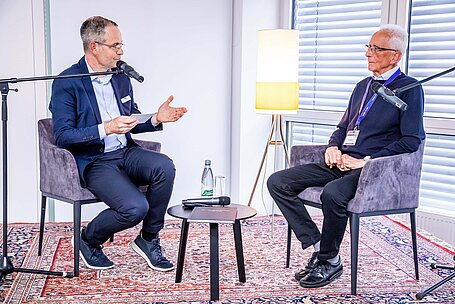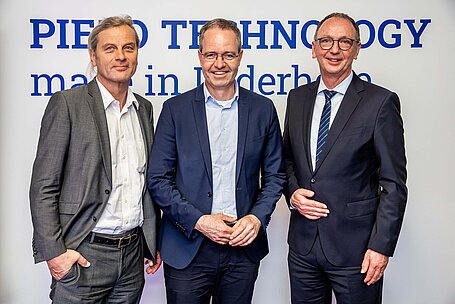- Events - PI Ceramic GmbH
75 Years of Piezo Technology - How Innovations from Germany Are Conquering World Markets



We encounter piezoelectric ceramics, also known as “piezos,” in many places in everyday life, for example, in lighters or gas stoves. The principle is always the same: Mechanical pressure on the component generates an electrical voltage that ignites the gas with a spark when discharged. This effect can also be utilized in reverse as piezoceramics change their length when an electrical voltage is applied. This enables various applications, such as generating ultrasound or constructing miniaturized, highly precise pumps, actuators, and motors.
How Innovations from Germany Are Conquering World Markets
In 1950, HESCHO-Kahla published a scientific report detailing the state of knowledge about the material at the time and developed the first range of piezoceramic materials under the name “Piezolan.” Thus, piezo technology was established in Germany at almost the same time as international developments. Since then, a German competence center for piezo technology has emerged in the region around the Hermsdorfer Kreuz interchange, and it still exists there today. Therefore, it is no coincidence that PI Ceramic was founded in the middle of this region, in the village of Lederhose, Germany, in 1992. PI Ceramic was originally intended to supply its parent company Physik Instrumente (PI), which is now the global market leader in high-precision positioning systems based on piezo actuators. Today, PI Ceramic supplies customers around the globe with piezoceramic components for the full range of modern applications of piezo technology, including piezoceramic tubes for picoliter-precise dosing of liquids such as medicines or printing inks, rings for nebulization in inhalers, or discs for generating ultrasound, among others. With over 400 employees, PI Ceramic is one of the largest employers in the region.
Symposium on May 14, 2025, in Lederhose
At PI Ceramic’s modern customer and visitor center, renowned speakers presented the technological history of piezoceramics as well as the latest material and application developments. These speakers included Dr. Dieter Grützmann from the board of Verein für Regional- und Technikgeschichte e.V. Hermsdorf, Prof. Dr. Jörg Töpfer from University of Applied Sciences Jena, and Prof. Dr.-Ing. Jörg Wallaschek from Leibniz University Hannover.
Prof. Töpfer illustrated the economic importance of piezoceramics based on an evaluation of a market study: “The study shows a global sales volume of 1.4 billion U.S. dollars for 2023, with a growth rate of approximately 4.9 %.”
Professor Wallaschek, an expert in piezo applications, explained some current applications of piezo technology, such as common rail injection systems, without which modern diesel engines would be unable to meet the Euro 6 emissions standard, or wire bonding in the semiconductor industry. For the future, Wallaschek sees many new applications, including drilling on Mars or levitation using ultrasound.
PI Ceramic Managing Director Dr. Patrick Pertsch emphasizes: “It is fascinating to support modern, future-oriented applications of piezoceramics every day with PI Ceramic’s diverse expertise, even though the material has been around for seventy-five years.”
PI Ceramic in Brief
Redefining the limits of what can be measured and moved, together with our customers: As a worldwide partner with over thirty years of expertise and more than 400 employees, PI Ceramic develops and manufactures piezoceramic components and subsystems for applications in the areas of medical technology, industrial ultrasonic sensors, and precision dosing. One hundred engineers develop customized solutions and provide advice and expertise. PI Ceramic is part of the PI Group, the innovation and market leader in high-precision positioning technology.
About the Verein für Regional- und Technikgeschichte e.V. Hermsdorf
Since its foundation in 1991, the association has been committed to documenting and reevaluating the region’s technological history. This history is closely tied to electroceramics, which were developed and manufactured by the former state-owned enterprise, Keramische Werke Hermsdorf, and its predecessor and successor companies. The association currently has twenty-five active members and operates a technical collection featuring a permanent exhibition at Hermsdorf Town Hall (>> www.vrtg.de).